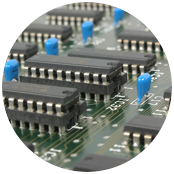Aluminum electrolytic capacitors consist of cathode aluminum foil, electrolytic capacitor paper, and a layer of aluminum oxide. The aluminum oxide layer acts as the dielectric and offers rectifying properties. In addition, the dielectric possesses an isolative property when in contact with the electrolyte, which prevents forward passage within the capacitor. The higher the purity of the aluminum foil, the greater the dielectric strength of the aluminum electrolytic capacitor.
Tecate's general-purpose axial and radial-leaded aluminum electrolytic capacitors range from 0.47μF to 15000μF at voltages from 6.3VDC to 450VDC. The standard temperature range for these devices is -40°C to +85°C, which is adequate for most industrial applications.
Aluminum electrolytic capacitors are available in one of two termination styles: leaded aluminum electrolytic capacitors and chip aluminum electrolytic capacitors. Leaded capacitors, as the name implies, connect to circuits via leads. Types of leads available for aluminum electrolytic capacitors include axial leads, radial leads, and snap-in leads.
Chip aluminum electrolytic capacitors, also referred to as "surface mount aluminum electrolytic capacitors," do not have leads. These parts come on tape and reel and can be mounted and soldered on a PCBA at very high speeds. Surface mount aluminum electrolytic capacitors are commonly used in applications where space is critical and cost per placement and maximum throughput are priorities. Tecate's line of chip aluminum electrolytic capacitors covers capacitance ranges from 0.1μF to 6800μF and voltages from 4.0VDC to 450VDC. These capacitors support a temperature range of -55°C to +125°C.


